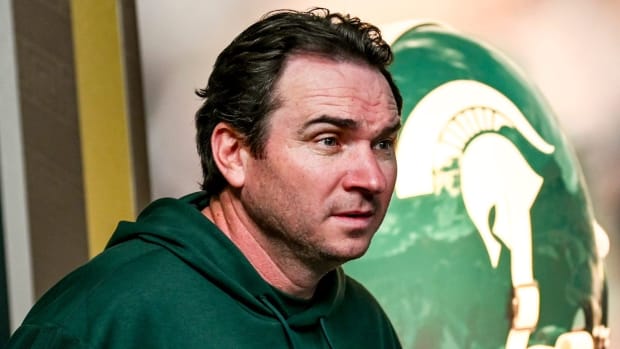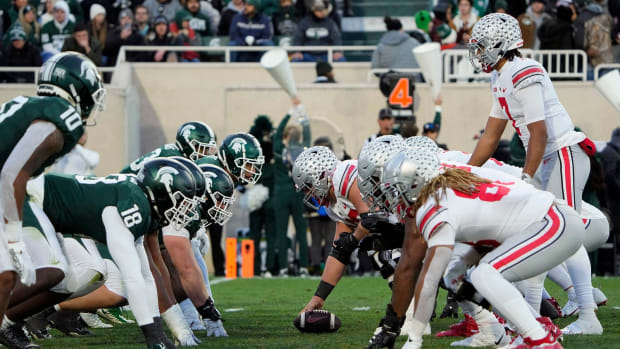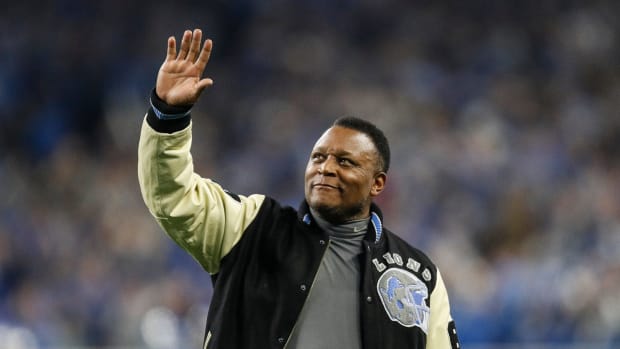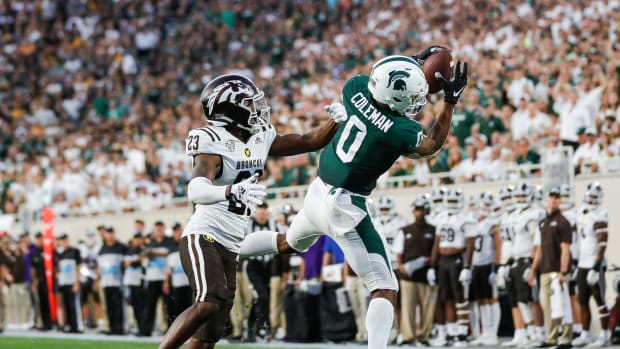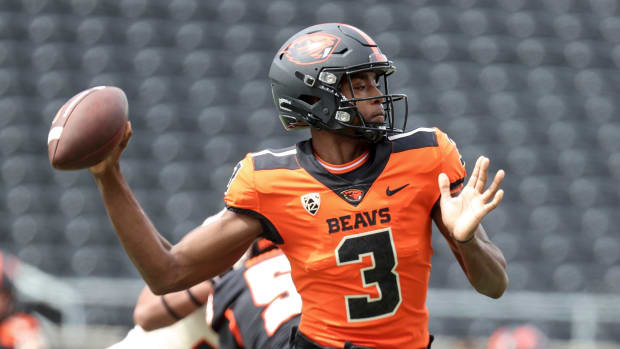Michigan State Football 2012 End of Year Report: Part Four
As we methodically look back at the 2012 season, we have the luxury of 20/20 vision. That is one of the only luxuries that looking back gives us. So much promise ended with a lot of disappointment.Â
If there was a silver lining it could be that Mark Dantonio has redefined what a disappointing season is. Now a bad year is a 7-6 finish. I know that the goals of the Spartan Nation are significantly higher, but if that is the new paradigm for the bad year, realistic Spartan fans will take that.
As we move forward with today’s article you need to understand the thinking process of Mark Dantonio. He sees his job as having three key components: 1) Graduate players 2) Develop young men 3) Win games. We will come back to this later in the article.
In part four today we take a look at scholarship numbers. Per the NCAA Bylaw 15.5.6.1, each division one football team is allowed 85 full scholarship student athletes. It is simple. This past year Michigan State took 18 players on national signing day. Here is a chart of how many other schools took.
How is it that some programs that usually are playing at a high level take consistently more per year than MSU? As stated the Spartans took 18 this past signing period.
There are three ways that teams can get around certain rules. You must remember that NCAA rules are NOT the law of the land. In my opinion the NCAA is one of the most corrupt and disingenuous organizations outside of Washington D.C. If they don’t like something, they can fix it. The two ways are through medical hardships and grayshirts and pressuring players to transfer.
Let’s start with grayshirts. Here is what a gray shirt is. When a player is grayshirted he literally signs his letter of intent during the first week of February with the rest of the class. But in this case he will delay his enrollment until the next year after the freshman football season for the other recruits is over. So he would arrive In January for the start of the new semester, but more importantly a new calendar year. The athlete does not report during the previous summer with other February signee recruits. The grayshirted player’s eligibility does not start until he is enrolled as a full-time student. Because he does so in another calendar year, it skirts the signing day rule limitations.
You may ask, "Why does that matter?" Because during every football season players get injured or don’t produce at the level anticipated. Some will decide (with the gentle push cough cough) to transfer, quit football, or take a medical hardship scholarship. When that happens the scholarship is available to be given to a player who grayshirted, thus skirting the technicality of the rule. Some find this practice unethical; some have no issue with it.Â
Here are three examples of grayshirting and the University of Alabama. Before you think that I am picking on Nick Saban or you think he is the only one doing it, you are wrong. The MSU administration has declared that they expect MSU football to win Big Ten titles and compete for national titles.
If that goal is germane you have to look at what the best are doing. Like it or not, Alabama is the best in college football. Whether you like or hate the rules, THEY AREN’T BREAKING THEM. It is like people who get angry every year because the New York Yankees spend so much money trying to win. Do you think the Yankees win by coincidence and are the most valuable club in the MLB? Why are the best college football programs the most financially successful?  They are on a mission.  Here are three examples of Alabama and grayshirting.
Example 1Â Â Â Â Example 2Â Â Â Â Example 3Â Â Â Please take a moment and click on each of those for a better understanding.
MSU does not participate in grayshirting. Dantonio has players walk on and earn the scholarships, but doesn’t have them actually stay out and then enroll in January.
Many would think that the reason that top schools that sign the maximum 25 of year is because they lose so many players early to the NFL. Of course they want that to be the narrative, but it isn’t reality. They sure do lose some players every year. They also can “move†players that aren’t performing at a high level with medical scholarships.
Let me explain. The NCAA is trying to protect the student aid of players who go to school, get injured, and can’t perform. To do that they allow teams to move them to a medical scholarship. The moment a player takes that medical scholarship the school still provides for them a full scholarship, but it no longer counts against the limit of 85.
Again, it is used in a wrong way by several programs. It just got the most national attention when the Wall Street Journal wrote about how it is a booming practice at Alabama under Saban. I encourage you to CLICK RIGHT HERE and read that before going forward with this article.
In looking over the Spartans roster for the Buffalo Wild Wings Bowl there were 20 scholarship players (at least) that would not have been on the roster of most high level programs based on their situation at MSU. That performance is based on two criteria: either medical or performance.
I am not saying that those 20 would have been recruited by the top schools. I am simply saying that based on what they have accomplished athletically so far or maybe better to say have not accomplished, they would be gone. I am not going to list all 20. There is no reason to embarrass a young man. What I will do is list a couple so you understand and in both cases neither is embarrassing. Both are super young men and hard workers.
Henry Conway came to MSU with a major upside as an OT. He suffered a horrible neck injury. Henry is one of my favorite players on this team, but after working hard to be able to play again, he has battled to see real action. He is a wonderful person and a great kid and it has NOTHING to do with effort. It is about numbers.
Paul Lang is a TE from Pittsburgh. Another great kid that before he ever played a down had a major back injury. Forget football, he had quality of life issues to worry about. Through nothing short of his amazing iron will, Lang not only is back, but playing. There are plenty of schools that when the injury hit, Lang would have been told he could have a medical or a transfer letter, but football was done.
So think about this. MSU went into the BWW Bowl with 20 scholarship players on the roster that wouldn’t have been on other high level teams.
It is not uncommon at other top schools when a player doesn’t perform to “FREEZE†him out. Simply ignore him, bury him on scout team, and make it clear he is everything short of contagious with a serious disease to make him so miserable he transfers.
All of these issues point to scholarship numbers. Recruiting is the lifeblood of college sports. You live by it and you die by it. Some schools accumulate the top talent like I do donuts and some accumulate more talent and develop it.
Top programs get rid of players either through “PUSHING†transfers or “GREATLY ENCOURAGING†medical scholarships and then using over-signing techniques such as grayshirting to stock their roster with more talent.
Do you think if MSU had gotten a do-over on the 20 scholarship players I mentioned from the BWW Bowl that it would have helped them? While the MSU coaching staff has those 20 players, some schools would have turned those original 20 scholarships and looked at a total of 40 or 50 players.Â
It isn’t that a Nick Saban or some of the top schools are that much better recruiters, they have the budgets to scour the nation to get more looks at kids. They also have the ability to bring more in to “Kick the tires.â€Â Barney the dinosaur could win at some level if he gets to see 50 players instead of just those 20.
Let me give you a real life example. I have a very good friend who is a pastor in the south. He had a son with all the things you want in an offensive lineman. He was tall, long arms, weighed over 300 pounds, he enjoyed lifting weights, and because of his God given physical features dominated smaller players in high school. He had great grades and is a super human being. I have known him his entire life.
This young man always talked about wanting to be a missionary. He enjoyed football, but it was not his passion. As he started to get recruiting letters the pressure mounted on him. He wanted to go to a small school so he could study ministry. His father pointed out to him many times that at the bigger programs of the Big 12 and SEC his life would be dominated by football. There is nothing wrong with that, but he knew that his son didn’t love football that way.
With all of the pressure he gave in and picked an SEC school that he was convinced by the recruiter would “Give you a bigger platform to share the gospel after you win a national championship.â€Â
This was prior to Tim Tebow, but the wise recruiter knew his passion and did a great job of selling him. Most schools ignored his passion for ministry; this school identified it and used it. Not in a cheating way or in a bad way, it worked for Tebow and they sold him the same opportunity before Tebow had done it.
This young man’s father told him, “Son there is nothing wrong with playing football or going to any of these schools, but is it fair to them and you if your heart isn’t in football? You are good now because you are bigger than everyone. Did you notice on your visit you aren’t the biggest anymore?â€
He ignored his father and went to the SEC school. He arrived in the summer and redshirted that first year. After his second spring football season concluded the director of football operations called him into his office. He informed the youngster that he had paperwork on his desk that said he was unable to play football because of a reoccurring ankle injury and was going to be put on a medical scholarship. Ending his football career, but still allowing the young man to attend school and remain on scholarship.
I personally think the thought of not having to play football was a good idea to him, but he couldn’t sign the papers because they were not true. He wasn’t going to lie to the NCAA. The football operations man essentially let him know that he was going to spend the next three years running stadium steps every day in practice and would never travel or play in a game. He even said, “We don’t think you will even dress for home games.â€
He transferred to a small college, played football, and is now a missionary. I told that story so you can see what MSU has to compete against.
I have no issues if a player isn’t performing telling him the truth. “Hey we love you, but if you want to play you may want to consider a transfer.â€Â I respect the honesty. I don’t want to see player regulated to running steps and essentially blackmailed into leaving. Coach Dantonio doesn’t do that. In fact, I think there have been some players he should have encouraged to go that he didn’t.Â
For Mark Dantonio he sees his three part job description simply: 1) Graduate players 2) Develop young men 3) Win games. He is no fool. He knows that the first two are more important, but he won’t get to do them without plenty of number three. You can call Dantonio a lot of things, but stupid is not one of them. Just because winning is third, does not mean it isn’t important and there is NO ONE more competitive than him.
Many of the top schools can sign more players for the reason listed in this article. MSU carries more “dead weight†than others. I love to see Henry Conway every practice. He isn’t the Henry Conway of old on the football field, but he works hard and every Spartan should be proud of him.
How about Paul Lang last year? Fighting back and getting reps. Spartan Nation should be proud of him. Neither Lang nor Conway is the proverbial “dead weight†that some coaches call it, but they are young men who in many programs would have been dropped.
Arthur Ray would have never been around MSU as long as he was if Dantonio didn’t take the compassionate approach rather than the approach used by so many others. I realize he wasn’t pleased last year, but Dantonio had done all he could do for Ray.
Dantonio would not have been wrong asking Lang or Conway to take a medical scholarship. He wasn’t wrong doing what he did either. The point is that college football is a business. CHECK OUT THIS CHART! The moment you think it isn’t you are fooling yourself. It is a multi-million dollar business from the NCAA down to the fan who can’t afford tickets, but buys a hat that says “MSU FOOTBALL.â€Â It would be foolish to not look in the mirror and ask what you want of your program and yourself without knowing the cost.
Bobby Bowden once told me an amazing fact that I have never forgot. He said, “If a young man is content not playing football then me and my coaches failed. If he isn’t playing and he comes in and says to me that he has to transfer because he loves this game and he only has so much eligibility that he has to go so he can use it. I shake his hands and commend the coach who recruited him. Not all kids work out at this level, but I sure want me football players that love the game. I look for that first when I recruit a kid.â€
MSU had 20 scholarship players that would not have been on the roster at other top schools, based on their health or performance at MSU. Some of those should make Spartan fans proud. Some of them should frustrate them.
The cold reality is that coming off back-to-back 11 win seasons; the Spartans roster did not reflect that success at some positions. You can’t have at least nearly 25% of your scholarship roster already major if not definite question marks.Â
I will not name names, the purpose of this article IS NOT to embarrass young men, but there are young men who are of high character and good people that played in 2012 that are not Rose Bowl, Big Ten title, and national championship caliber players. That is a fact that no coach at MSU will dispute. The roster for last season was not the roster that back-to-back 11 wins season should produce. There were players on the field that didn’t belong. That greatly contributed to the lack of success and frankly disappointment in 2012.
To put it blunter and more simply: the 2012 MSU Football Roster was NOT a Rose Bowl Roster at certain positions. In later articles we will look at them, but it wasn't there.
I leave you with this. I often hear why doesn’t the NCAA change things? First, that would be a question for MSU President Simon. She is the executive chair of the committee that runs the NCAA and recently came out and endorsed the failed leadership of the NCAA chief Mark Emmert.
Secondly, you do what my father always taught: “Follow the money.â€Â The NCAA has an interest in the success because that means dollars. Why would the Big Ten commissioner and arguablythe most powerful man in sports, Jim Delany, not petition theNCAA when they agreed to have ineligible players for OSU play in the bowl game and serve their suspension for improper behavior at the start of the next year? Bowls equal dollars. We can all say it is about the student athletes, but that is a lie. It is about money.
I can stand in front of a mirror and tell myself how small and thin I am, but it doesn’t change reality.Â
Tomorrow we go from looking at the forest to zeroing in on more specifics. We turn our attention to the MSU QB situation. Did the MSU staff unknowingly set Maxwell up to struggle and what are the issues surrounding that position?
Â
Michigan State Football End of Year Report Part One
